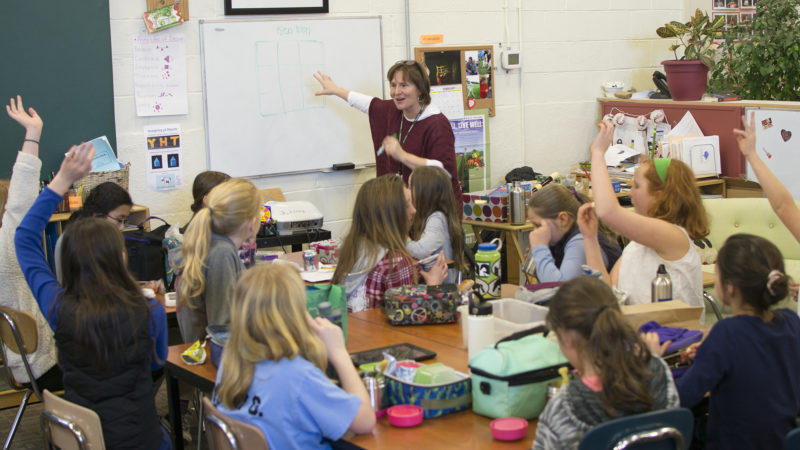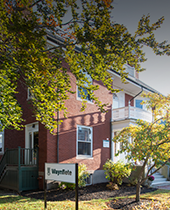PB&J, carrot sticks, and math
Thursday morning recess is over, and students in Waynflete’s multiage grades 2-3 program return to their home stations. Teachers begin to move tables together to accommodate the 20 or more children who—lunch bags in hand—are beginning to assemble. Students begin to quiet down, turning their attention to Lower School Director Anne Hopkins as she begins writing today’s problem on the whiteboard. It’s time for math lunch.
Anne brings close to 30 years of math instruction experience to Waynflete. With help from Math Department Chair Lisa Kramer, Learning Specialist Heather Tanquay, and Lower School advisors, Anne now runs two math lunches a week for grades 2-3 and 4-5 students. And the kids are lining up!
Anne and others carefully select “low-floor, high-ceiling” problems that allow all students to participate and stretch. “We call them ‘desirable difficulties,’” says Anne. “We want kids to push, but don’t want to scare them away by thinking they need a certain level of prowess.” Teachers encourage all students in grades 2 through 5 to participate.
Teachers use diverse problem types to keep the activity fresh. One lunch might focus on a problem that encourages individual work, while the following week might introduce a hands-on puzzle that encourages cooperation. Many problems work equally well for both age groups, though 4-5 students have the opportunity to use more advanced math operations. (For example, 4-5 students might use a square root to solve a problem, while 2-3 students will have to find another path).
Fourth-grader Molly was excited to learn about the new activity at the start of the school year. “Anne told us that she was starting a new lunch where we’d learn about math, and that it would be fun,” she says. “The best part is working on a problem and having everyone around to help. If someone figures out an answer to something, they’ll explain how they did it.”
Some students use the session to begin working on a problem, with plans to take it home afterwards (teachers may also include the problem in the student’s individualized weekly work plan). Students will often check in with Anne later in the week so they can hand in the completed worksheet, ask a question if they’re stuck, or simply share an “aha” moment. Particularly challenging problems may require two weeks of work as a group.
For Anne, math lunches fit perfectly into a curriculum that increasingly emphasizes a STEAM (science, technology, engineering, arts, and mathematics) approach to learning. “Math instruction in this country has traditionally been about memorizing and implementing procedures,” she says. “The change we’re driving emphasizes conceptual understanding and creative application of problem-solving skills. It’s design thinking, which can be applied to any topic.”
Want to tackle some math lunch problems on your own? Here are two examples from recent grades 2-3 and 4-5 math lunches:
2-3
Click here to view an Olympics-related challenge!
4-5
Using the digits 2,0,1, and 8 each once, and any mathematical symbol or operation, make as many “math sentences” as you can that equal the digits 1 to 100.
(For example: “10 times 8 subtract 2 equals 78.”)




